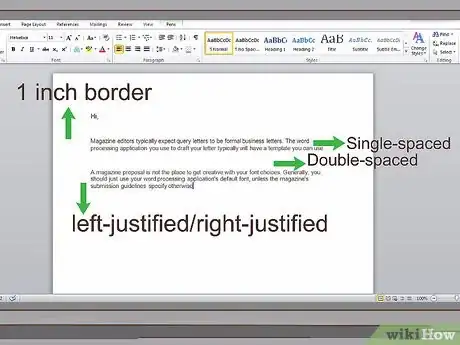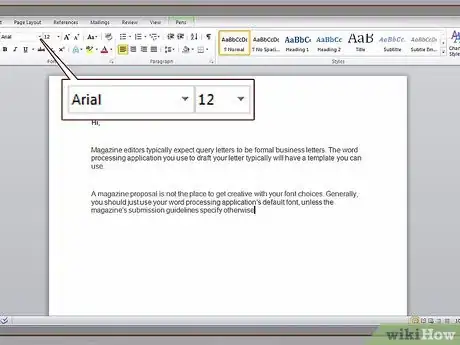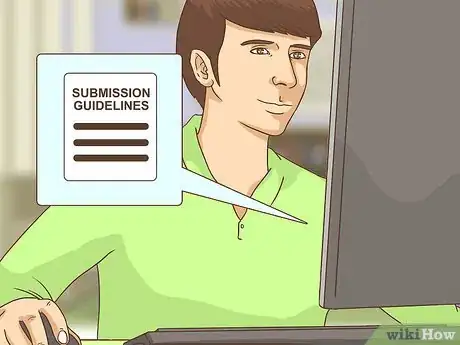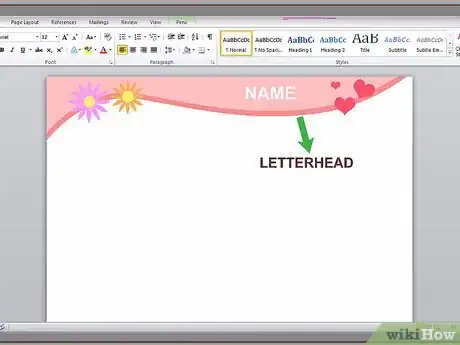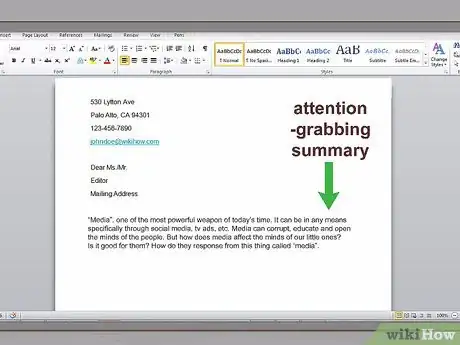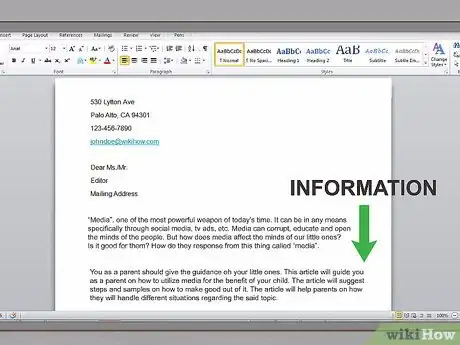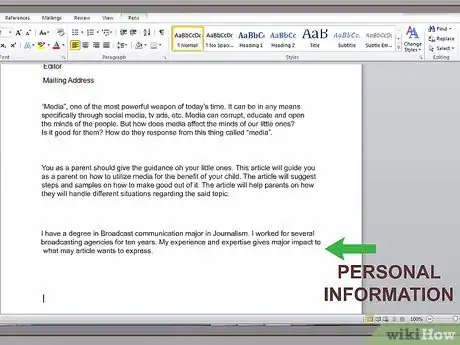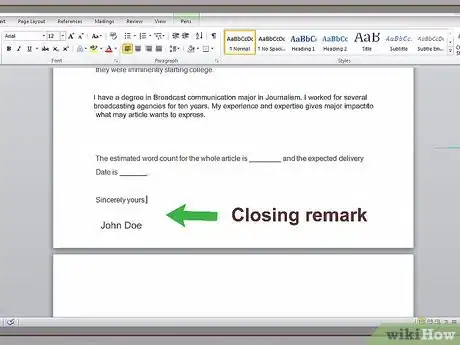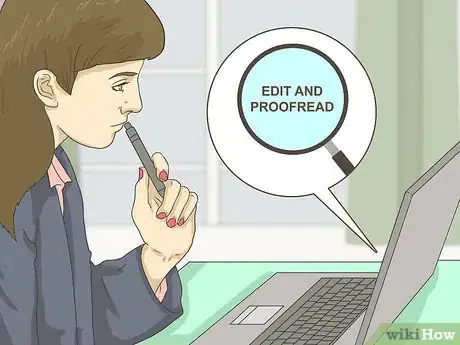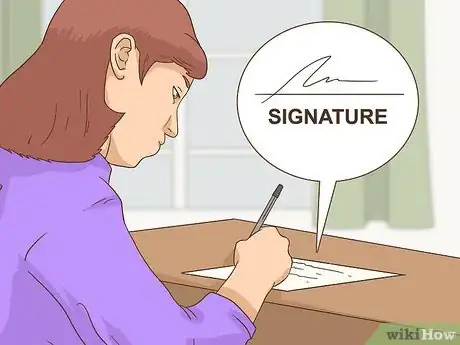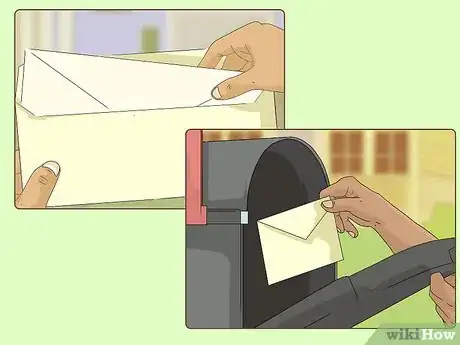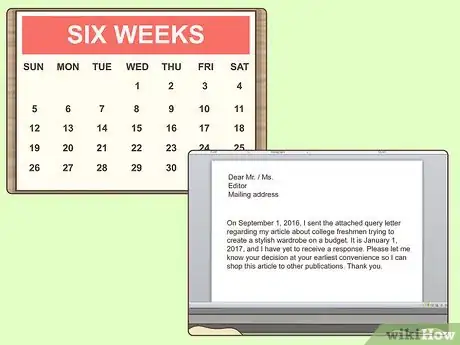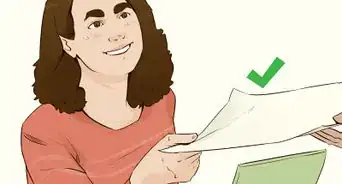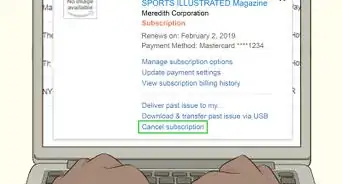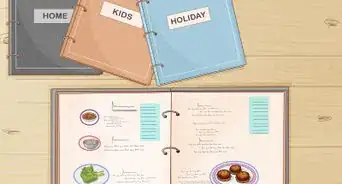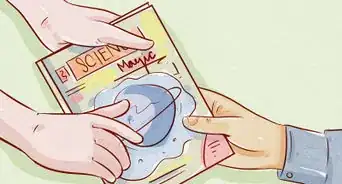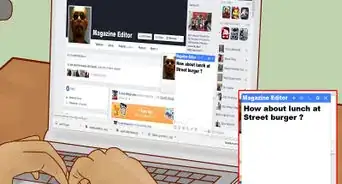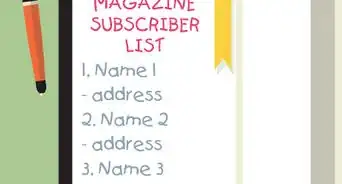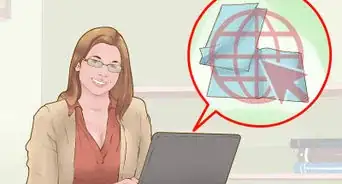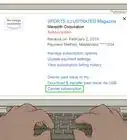This article was co-authored by Gerald Posner and by wikiHow staff writer, Jennifer Mueller, JD. Gerald Posner is an Author & Journalist based in Miami, Florida. With over 35 years of experience, he specializes in investigative journalism, nonfiction books, and editorials. He holds a law degree from UC College of the Law, San Francisco, and a BA in Political Science from the University of California-Berkeley. He’s the author of thirteen books, including several New York Times bestsellers, the winner of the Florida Book Award for General Nonfiction, and has been a finalist for the Pulitzer Prize in History. He was also shortlisted for the Best Business Book of 2020 by the Society for Advancing Business Editing and Writing.
This article has been viewed 65,049 times.
If you want to see your writing published in a magazine, you must first write a magazine proposal or query letter. When you pitch your article to the magazine, the magazine's editors will quickly assess your writing style and capability, as well as judging whether your article would be a good fit for their publication.[1] Our guide has all the tips to show you how to write the perfect pitch so you can get your article published in a magazine!
Steps
Formatting Your Proposal
-
1Use traditional business-letter format. Magazine editors typically expect query letters to be formal business letters. The word processing application you use to draft your letter typically will have a template you can use.[2]
- The template should provide for one-inch margins on all sides of the page.
- Text should be single-spaced, with a double space between paragraphs. Do not indent your paragraphs. This is known as the "block paragraph" format, and is generally easier to read.
- Your text should be left-justified, or right-justified if you are writing in a language that is read from right to left.
- Try to keep your overall letter to one page. Keep in mind that many editors read hundreds (if not thousands) of queries each week. You don't want to monopolize their time.
-
2Choose a common, readable font. A magazine proposal is not the place to get creative with your font choices. Generally, you should just use your word processing application's default font, unless the magazine's submission guidelines specify otherwise.
- While the submission guidelines may not indicate preference for a particular font, they may state whether to use a serif or sans-serif font. Times New Roman is a good example of a serif font, while Helvetica and Arial are sans-serif fonts.
- If you can identify the font the magazine uses and use that in your letter, it can be a nice touch.
- For readability, your text ideally should be 12-point size. If your letter is on the longish side, you may want to decrease the font size so it'll fit on one page, but don't go smaller than 10-point.
Advertisement -
3Read the publication's submission guidelines. You typically will find information about a magazine's submission guidelines somewhere within the first few pages of the magazine (look on the page with other publication information) or on the magazine's website.
- If the magazine's technical specifications regarding format differ from those on your template, make sure you adjust them to meet the magazine's specifications.
- Most magazines publish submission guidelines in several places, so it shouldn't be difficult to find. However, if you are unable to find specific submission guidelines, call or email using the contact information provided and ask for them. Don't simply send your query cold – you may not receive any response.
- While some aspects of submission guidelines may seem overly nit-picky to you, part of the purpose is to demonstrate that you are capable of following instructions. As you read through the guidelines, give the editors the benefit of the doubt that they have a legitimate reason for every requirement, regardless of how irrelevant or unimportant it seems to you.
-
4Create a universal header. If you plan to submit multiple queries, either of this article or of several different articles, taking the time to format your own letterhead will save you time and make your letter look more professional.[3]
- Most word processing applications have various templates you can use to create your own letterhead. Once you've made it once, you can use it for every query letter you write.
- Your header should reflect your personal brand and reputation as a writer, so think about your background and the types of articles you want to write.
- For example, if you are a parent and most of your articles are personal essays and informative articles about parenting, you probably could get away with cute graphics in your header that implicated children. However, if you are writing more serious medical or legal articles about child rearing, you would want the style of your header to reflect an appropriate degree of professionalism.
-
5Include your name and contact information. If you've chosen not to create letterhead, the traditional spot in a business letter to provide your own name, address, and other contact information is the top right-hand corner of the page.
- If you're using a business-letter template, it may already have this block formatted for you. Otherwise, simply type the information, hitting return after each line. Then highlight the entire block and change the formatting for the selected text to right-justified.
-
6Address your letter to a specific person and greet them appropriately. Below your own contact information, double-space and then type the name and professional title of the person to whom you're writing, along with the mailing address of the publication.[4]
- A magazine proposal should always be addressed to a specific editor by name. If the submission guidelines don't provide the name of the person to whom you should send your query, you'll have to do a little research to find out who they are. But if you're unable to do the work required to find this out, whoever reads your letter will probably gather from this that you also are unable to complete the necessary research to write a quality article for their magazine.
- Use a formal greeting for this person, opening your letter with "Dear Ms. (or Mr.) Editor." Don't assume the person's gender. You may have to do some research to find out their gender identity, but making an assumption based on their name can set you up for an instant rejection if you're wrong.
- If the editor identifies as female, don't use titles such as "Mrs." or "Miss," which assume their marital status, unless you have specific information that they prefer one of those titles.
Writing Your Proposal
-
1Research the publication you're querying. If you want a magazine to publish your writing, you must be able to tell the editor how your article will fit in with the rest of their content and appeal to their target audience. This requires reading the publication extensively.
- The more familiar you are with the publication, the better you'll be able to write your article in a similar style to other pieces they publish. If this seems like a lot of work to you, keep in mind that sending a proposal to a magazine that publishes articles similar to yours will greatly increase your chances of publication.
- Another reason to read the magazine is to make sure they haven't published an article previously that was too similar to yours – on the same topic, or taking the same angle. For example, you may have an article based on an interview with a local elementary school teacher who runs a toy drive for needy children on their birthdays. However, if you pitch your article to a magazine that has already run a story about the same teacher, not only will they not publish your story, but you'll acquire a bad reputation with that editor.
- Many areas have several magazines that cover the same subject matter, but for specific niche audiences. For example, there are many women's fashion magazines, but each target women of a particular age and socio-economic status. Some focus on young mothers, while others may focus on young professionals or teenagers. While there may be some overlap, you'll stand your best chances of getting your proposal approved if your article appeals to that magazine's core audience.
- If you're merely sending blanket queries to every publication within a specific niche, the editors will see this. Your query letter should be targeted specifically to each editor (if you send more than one) and address each publication.
-
2Open with an attention-grabbing summary. The first paragraph of your query letter should make the editor want to read your article and learn more about the subject you've proposed. Explain what is unique about your article, or about your angle of approach to your topic.[5]
- If there have been other articles written on your topic – especially in the magazine you're querying – mention them up front. This can be an effective way to get the editor's attention. If they've already assigned several stories about something, it's clear they're interested in it. If you have a unique perspective or an angle they haven't considered, chances are they'll be highly interested in your article.
- It can take time and effort to develop a good "hook" that will really grab the editor. Although it may come to you immediately, you should expect to go through several drafts. This is a part of your query that you may want to read back to friends or family and get their opinion on it.
- There are some hooks or angles that you should avoid in your opening paragraph. If this would be your first publication, don't lead with that fact – the editor may not read any further. You also shouldn't start with a throat-clearing phrase such as "my article is about." Just go right into it.
- While it is appropriate in other contexts to begin your letter by introducing yourself, that isn't the best way to begin a query letter. The purpose of your letter is to sell your article – not to sell yourself.
-
3Provide further information about your article. Use the second paragraph of your magazine proposal to let the editor know anything else about your article that might impact the editor's decision to publish it.[6]
- Identify the audience of the article and explain why you think your article would appeal to them. Make sure this audience is one the magazine targets (you'll know this from your research).
- For example, suppose you've written an article for female college freshmen looking to create a stylish wardrobe on a limited budget. You might send magazine proposals to women's fashion magazines that are geared towards teenagers. If you send a proposal to a magazine that focuses on women in their early 20s, that audience is likely too old for your article. But high schoolers would be interested in planning ahead, especially if they were imminently starting college.
- This is also a place to go into your process, if it's relevant to the final article. Explain how you came up with the idea, or the people you've interviewed to get information.
- While this may be the longest paragraph in your proposal, it still shouldn't be more than four or five sentences. Be concise. If the editor wants to see more, they'll let you know. The point of a query letter is that you give them enough information to make a decision as to whether they want to read your article.
-
4Include information about yourself. Provided the editor is interested in your article, they also want to know why you are the ideal person to write it. Use the third paragraph of your query letter to tell the editor about any personal or professional experience you have that relates to the topic of your article.[7]
- For example, if you have a college degree or job experience that provides you with particular expertise regarding the topic of your article, you should mention this. If it's not immediately obvious, you'll want to include a sentence explaining why the educational or work experience you have is related to your article.
- Particularly with personal essays, you'll also want to relate personal experience that makes you uniquely suited to write this article. The experience or traits you tell the editor about should be things that make your particular point of view compelling, or apart from the traditional narrative concerning the topic your article addresses.
- If you've had articles published elsewhere, particularly if they touch on similar topics, this is the place to mention those. Note whether you've included clips along with your article.
-
5Provide an estimated word count and delivery date. Refer to the magazine's submission guidelines to find out what their maximum word count is, and whether they have an estimated timeline for publication.[8]
- Do not propose an article that goes beyond the magazine's established maximum word count. If your article is longer than it should be, it's your job to trim it to meet the magazine's specifications – not theirs. An article that's too long isn't doing the editor any favors. It can be just as difficult to cut an article down as it is to add to it.
- If you've already finished the article, you can simply state "A first draft is available immediately upon your request." Keep in mind that the editor may suggest changes or additional research before your article is ready for publication.
- If you plan to query multiple publications at the same time, simply say "I am making simultaneous queries." You don't have to include information about the publications you've also queried – if the editor is curious, they may ask you when they follow up on your query.
-
6Thank the editor for their time. Editors are busy people, and have to sift through hundreds of queries. Show that you appreciate them and their work, and they'll typically treat you with equal respect. Include a single sentence as a separate paragraph, or at the end of your final paragraph.
- Avoid saying "thank you for your consideration." It sends a subtle sign that you don't expect the editor to accept your piece. You don't want them to merely consider your article – you want them to publish it.
- Simply thank them for their time, and tell them you look forward to hearing from them.
- Close your letter with a formal and professional closing such as "Sincerely yours," with space for your signature. Type your name under that space, then include your preferred method of communication (typically your phone number or email address) below your name.
Submitting Your Proposal
-
1Edit and proofread carefully. A magazine editor has a sharp eye for grammar and punctuation. A single typo in a one-page query letter can destroy your chances of getting published. The editor will assume you are careless, and that your article writing is equally careless.[9]
- One good way to proofread is to start at the end of your letter and move backwards. When you read backwards, errors will jump out at you that your eyes would have skimmed right over otherwise.
- You also should read your letter out loud. This will not only help you identify typos or grammatical errors, but can help you find sentences or passages that don't flow well or lack the transitions necessary to enable one part to move smoothly into the next. If you find yourself stumbling as you read, figure out a way to rewrite that passage so it's easier to read.
- You may want someone else to read over your letter as well. A pair of fresh eyes may be able to catch errors or identify trouble spots that you didn't see before.
-
2Finalize your letter. When you've thoroughly edited your letter and are confident that it's as strong as it can be, you're ready to print it out and sign it so you can send it to the editor. Use thick, quality paper to print your letter.[10]
- You can get bond paper at a stationery or office supply store. You may see many different colors, but don't use anything other than white or perhaps ivory.
- Print your letter using black ink. It's okay if you have a letterhead that uses some color, but generally you want to keep color to a minimum.
- Sign your letter using blue or blank ink. Make at least one copy of your signed letter for your records before you mail it.
-
3Mail your proposal to the magazine. Many publications still expect you to mail magazine proposals rather than sending them using email. Even if the publication accepts proposals through email, editors typically take a mailed proposal more seriously.[11]
- If the publication has asked for clips, or additional information to be submitted along with your letter, make sure you've included everything listed in the publication's submission guidelines.
- You may not have everything asked for in the submission guidelines. For example, the publication may ask for three previously published clips, but you don't have any as this article would be your first publication. In that case, include a brief sentence explaining this at the end of your query letter.
- Avoid sending a full copy of your article, even if you already have it written. Wait until you have word from the editor that they plan to publish your piece. While you do have intellectual property rights in your article from the moment you create it, those rights are extremely difficult to enforce should a less-ethical editor decide to steal your content.
- Use a regular, letter-sized envelope with your letter folded into thirds, unless your letter and enclosures are more than three or four pages. Then you should use a larger manilla envelope so the pages can remain flat.
-
4Wait for a response. Most magazines provide an estimated response time in their submission guidelines. Add at least two weeks to that time, measured from the date you mailed your proposal, and do not contact the editor before that date.[12]
- If no response time is provided, wait at least six weeks before following up on your magazine proposal.
- When you follow up, send a polite, formal letter inquiring as to the status of your proposal. This needn't be more than a couple of sentences. Include a copy of your original letter, so the editor doesn't have to go hunting for it.
- For example, you might write "On September 1, 2016, I sent the attached query letter regarding my article about college freshmen trying to create a stylish wardrobe on a budget. It is January 1, 2017, and I have yet to receive a response. Please let me know your decision at your earliest convenience so I can shop this article to other publications. Thank you."
- If you don't hear anything within a couple of weeks of sending that letter, you might consider a polite phone call – especially if you're determined to get your article in that particular magazine. Otherwise, you should simply write it off and feel free to query other magazines until you find the right home for your story. However, you might want to send another letter withdrawing your article from consideration.
- If you've sent queries to several magazines and one has expressed interest, you don't have to wait until the end of the response time to contact the other magazines. Call or email the editor and let them know that someone else has expressed interest in the piece and that you are withdrawing it from their consideration.
Expert Q&A
-
QuestionHow do you write a good magazine article proposal?
 Gerald PosnerGerald Posner is an Author & Journalist based in Miami, Florida. With over 35 years of experience, he specializes in investigative journalism, nonfiction books, and editorials. He holds a law degree from UC College of the Law, San Francisco, and a BA in Political Science from the University of California-Berkeley. He’s the author of thirteen books, including several New York Times bestsellers, the winner of the Florida Book Award for General Nonfiction, and has been a finalist for the Pulitzer Prize in History. He was also shortlisted for the Best Business Book of 2020 by the Society for Advancing Business Editing and Writing.
Gerald PosnerGerald Posner is an Author & Journalist based in Miami, Florida. With over 35 years of experience, he specializes in investigative journalism, nonfiction books, and editorials. He holds a law degree from UC College of the Law, San Francisco, and a BA in Political Science from the University of California-Berkeley. He’s the author of thirteen books, including several New York Times bestsellers, the winner of the Florida Book Award for General Nonfiction, and has been a finalist for the Pulitzer Prize in History. He was also shortlisted for the Best Business Book of 2020 by the Society for Advancing Business Editing and Writing.
Author & Journalist A good magazine proposal needs to explain 1) what you want to write about; 2) how what you want to write is different than what everyone else has covered on the same topic; and 3) why you are the best writer to do it. There's nothing more irritating for editors than getting generic pitches that are obviously being sent to a bunch of other places.
A good magazine proposal needs to explain 1) what you want to write about; 2) how what you want to write is different than what everyone else has covered on the same topic; and 3) why you are the best writer to do it. There's nothing more irritating for editors than getting generic pitches that are obviously being sent to a bunch of other places. -
QuestionHow do you write a fictional book proposal?
 Gerald PosnerGerald Posner is an Author & Journalist based in Miami, Florida. With over 35 years of experience, he specializes in investigative journalism, nonfiction books, and editorials. He holds a law degree from UC College of the Law, San Francisco, and a BA in Political Science from the University of California-Berkeley. He’s the author of thirteen books, including several New York Times bestsellers, the winner of the Florida Book Award for General Nonfiction, and has been a finalist for the Pulitzer Prize in History. He was also shortlisted for the Best Business Book of 2020 by the Society for Advancing Business Editing and Writing.
Gerald PosnerGerald Posner is an Author & Journalist based in Miami, Florida. With over 35 years of experience, he specializes in investigative journalism, nonfiction books, and editorials. He holds a law degree from UC College of the Law, San Francisco, and a BA in Political Science from the University of California-Berkeley. He’s the author of thirteen books, including several New York Times bestsellers, the winner of the Florida Book Award for General Nonfiction, and has been a finalist for the Pulitzer Prize in History. He was also shortlisted for the Best Business Book of 2020 by the Society for Advancing Business Editing and Writing.
Author & Journalist Assume that they've never seen your writing before! Tell them what the novel is about in a page or two, and then show them a 20-30 page sample of your novel. You don't want to give them 100 pages—just enough where it's really going to catch their attention. From there, they'll decide whether they'll going to pass it around to the other editors at the house or not.
Assume that they've never seen your writing before! Tell them what the novel is about in a page or two, and then show them a 20-30 page sample of your novel. You don't want to give them 100 pages—just enough where it's really going to catch their attention. From there, they'll decide whether they'll going to pass it around to the other editors at the house or not. -
QuestionCan I send article I wrote via email?
 Community AnswerYes, most magazines accept submissions via email. Check their website for information.
Community AnswerYes, most magazines accept submissions via email. Check their website for information.
Expert Interview
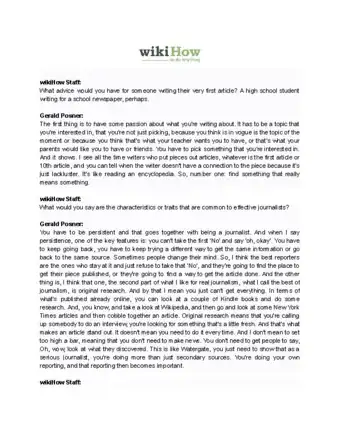
Thanks for reading our article! If you'd like to learn more about writing as a career, check out our in-depth interview with Gerald Posner.
References
- ↑ https://www.freelancewriting.com/freelancing/how-to-write-a-successful-query/
- ↑ https://www.freelancewriting.com/freelancing/how-to-write-a-successful-query/
- ↑ https://www.freelancewriting.com/query-letters/how-to-write-query-letter/
- ↑ https://www.freelancewriting.com/query-letters/how-to-write-query-letter/
- ↑ https://www.freelancewriting.com/query-letters/how-to-write-query-letter/
- ↑ https://www.freelancewriting.com/query-letters/how-to-write-query-letter/
- ↑ https://www.freelancewriting.com/query-letters/how-to-write-query-letter/
- ↑ https://www.freelancewriting.com/query-letters/queries-versus-articles/
- ↑ https://www.freelancewriting.com/query-letters/queries-versus-articles/
